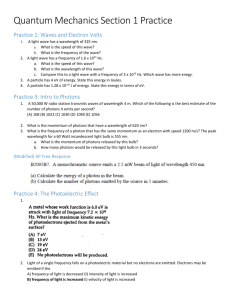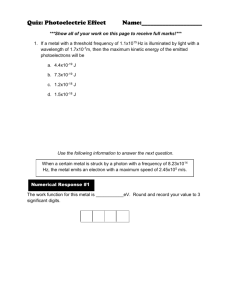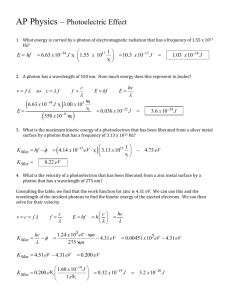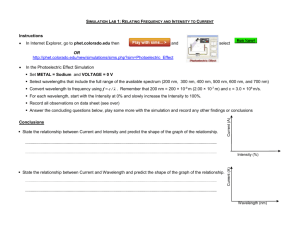Answers
advertisement
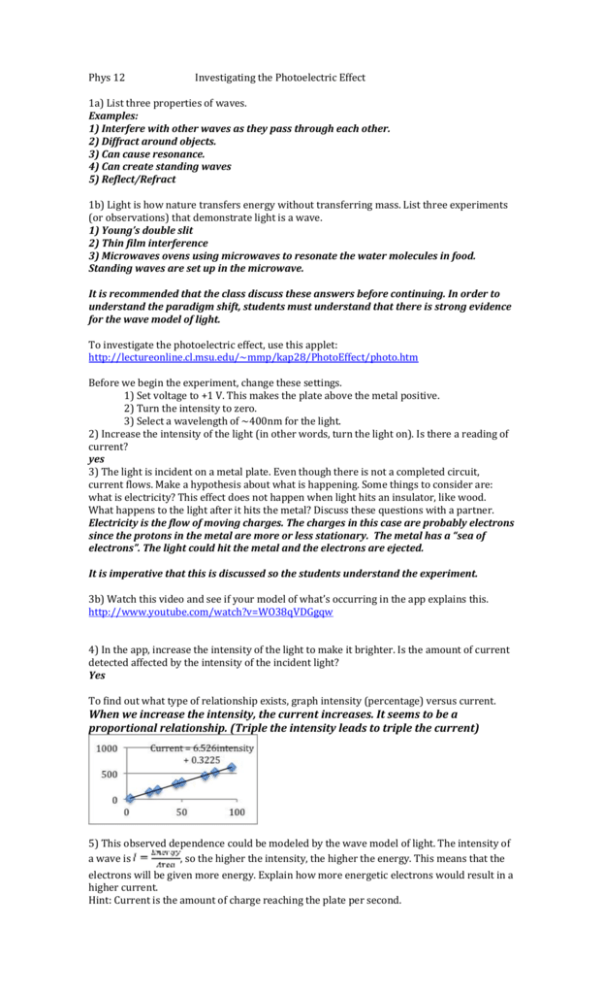
Phys 12 Investigating the Photoelectric Effect 1a) List three properties of waves. Examples: 1) Interfere with other waves as they pass through each other. 2) Diffract around objects. 3) Can cause resonance. 4) Can create standing waves 5) Reflect/Refract 1b) Light is how nature transfers energy without transferring mass. List three experiments (or observations) that demonstrate light is a wave. 1) Young’s double slit 2) Thin film interference 3) Microwaves ovens using microwaves to resonate the water molecules in food. Standing waves are set up in the microwave. It is recommended that the class discuss these answers before continuing. In order to understand the paradigm shift, students must understand that there is strong evidence for the wave model of light. To investigate the photoelectric effect, use this applet: http://lectureonline.cl.msu.edu/~mmp/kap28/PhotoEffect/photo.htm Before we begin the experiment, change these settings. 1) Set voltage to +1 V. This makes the plate above the metal positive. 2) Turn the intensity to zero. 3) Select a wavelength of ~400nm for the light. 2) Increase the intensity of the light (in other words, turn the light on). Is there a reading of current? yes 3) The light is incident on a metal plate. Even though there is not a completed circuit, current flows. Make a hypothesis about what is happening. Some things to consider are: what is electricity? This effect does not happen when light hits an insulator, like wood. What happens to the light after it hits the metal? Discuss these questions with a partner. Electricity is the flow of moving charges. The charges in this case are probably electrons since the protons in the metal are more or less stationary. The metal has a “sea of electrons”. The light could hit the metal and the electrons are ejected. It is imperative that this is discussed so the students understand the experiment. 3b) Watch this video and see if your model of what’s occurring in the app explains this. http://www.youtube.com/watch?v=WO38qVDGgqw 4) In the app, increase the intensity of the light to make it brighter. Is the amount of current detected affected by the intensity of the incident light? Yes To find out what type of relationship exists, graph intensity (percentage) versus current. When we increase the intensity, the current increases. It seems to be a proportional relationship. (Triple the intensity leads to triple the current) 5) This observed dependence could be modeled by the wave model of light. The intensity of a wave is , so the higher the intensity, the higher the energy. This means that the electrons will be given more energy. Explain how more energetic electrons would result in a higher current. Hint: Current is the amount of charge reaching the plate per second. If the electrons were more energetic, they would be moving faster. Since they are moving faster, more of them would hit the plate per second meaning a higher current. 6) We can find the energy of the emitted electrons, or photoelectrons. If we make the collecting plate negative enough, the photoelectrons will be repelled back to the metal. To do so, we create a potential difference between the plates. What is the potential energy of a photoelectron if it just stops at the negative plate, after traveling though a potential difference of ΔV? EQ = ΔVq 7) How does this amount of potential energy compare to the electron’s initial kinetic energy? This potential energy would be the initial kinetic energy of the electrons. 8) Predict what will happen to the stopping potential when we increase the intensity of the wave. Remember, the intensity of a wave is proportional to the energy of the wave. An increase in intensity means the wave is more energetic. Therefore more energy is transferred to the electrons. The electrons have more energy and so a higher stopping potential is required to stop them. Let’s measure the potential difference needed to stop the photoelectrons for different intensities. To measure the stopping potential, change the voltage so the current first reads zero. Then change the intensity and find the new stopping potential. 9) How does the stopping potential depend on the intensity? It doesn’t depend on the intensity. 10) What can we conclude about the kinetic energy of the photoelectrons? Justify with reference to your answers in 6-9. The kinetic energy of the electrons can be measured by using the stopping potential. This kinetic energy is not dependent on the intensity. 11) In this section, we are trying to discover why increasing the intensity of the light leads to a higher current reading. In question 5, you hypothesized about the increased current being due more energetic electrons. If the increased current is not due to more energetic electrons, what is causes it? Increasing the intensity does not increase the energy of the electrons. It simply means more electrons must be emitted from the metal, which explains the increased current. 12) Change the settings to: I = 50%, Voltage = 0 V and wavelength ~700nm. Does the photoelectric effect occur? How will you tell if it does? No the effect does not occur since there is no current read in the ammeter. 13) Since light is a wave, the electrons could resonate off the metal. It just might take some time for the electron to vibrate enough. (Light causing resonance is how a microwave oven works.) Leave the applet running. While it’s running, describe what decreasing the wavelength does to the frequency of a wave. Decreasing the wavelength increases the frequency. 14) Did the photoelectric effect happen after a few moments? What can we conclude? No the effect does not occur even after some time. The electrons are not resonating off the surface. 15) Decrease the wavelength slowly (to around 400nm) and state your observations. There is a wavelength when the effect starts to occur. 16) There exists a frequency below which no electrons are emitted. Is this frequency the same for both metals? No the wavelength (and frequency) is different for each metal. The frequency of the light seems to determine whether the photoelectric effect will occur for a certain metal. In wave theory, the frequency of the wave has no effect on the energy of the wave. (For example, 2 tuning forks of different frequencies will not have different volumes just because they have different frequencies.) Does the frequency of light determine the energy of the light? We’ll answers a few more questions before we get to answer this one. 17) How did we measure the electron’s initial kinetic energy? We used the stopping potential to find its potential energy. 18) Make the photoelectric effect occur with 0V across the plates. Add a small negative voltage across the plates. Does this affect the current? How can this be? The current drops some. This means that some of the electrons are stopped but some still have enough energy to make it to the collector plate. 19) Does every electron emitted have the same initial kinetic energy? No. If they did, there would be no drop in the current until it drops to zero all at once. The stopping potential will be used to measure the maximum kinetic energy of the electrons, since this potential stops even the most energetic electrons from reaching the negative plate. 20) How can we see if the maximum energy of the electrons is related to the frequency of the incident light? Is it? How so? We could change the frequency and see if that changes the stopping potential. It does. Increasing the frequency of the light increases the stopping potential. 21) The electrons do not naturally have enough energy to move to the positive plate. Where must this extra energy come from? The extra energy must come from the light hitting the metal. 22) What does this mean about the relationship between the energy of light and its frequency? The energy of the light is related to its frequency. 23) Does the frequency of light determine the energy of the light? Yes, it seems to. 24) The photoelectric effect shows that light cannot be modeled with a wave. Record the 3 reasons where the wave model breaks down. 1) The energy of the light is dependent on its intensity. 2) The electrons are not resonating off the metal since the effect either occurs immediately or it never does. 3) The frequency of the light is shown to determine its energy. Part 2: The Particle Model of Light We have concluded that the wave model of light does not successfully explain the results of the photoelectric effect. We will look at the data a little closer in this part of the investigation. We know that the maximum initial kinetic energy of the electrons can be measured using the stopping potential. And we know that the kinetic energy of the electrons is dependent on frequency of the incident light. Let’s discover exactly how they are related. Purpose: To discover the relationship between the frequency of the incident light and the kinetic energy of the photoelectrons. (In other words, to completely change Physics forever.) Procedure: Run the photoelectric effect applet from PhET http://phet.colorado.edu/en/simulation/photoelectric Turn the light on (by increasing the intensity). Record the wavelength of light used. Change the potential across the plates using the slider. Record the stopping potential (the potential which drops the current to zero). Change the wavelength and find the corresponding stopping potential. NOTE: In this applet, the potential changes by 0.20 V increments. This is not very precise. To obtain better data, we can change the way the experiment was done. Select a voltage across the plates. Increase the wavelength until current is read then decrease the wavelength until the current is the zero. The voltage across the plates is the stopping potential needed for that wavelength of light. (This is opposite to the way the experiment should be run.) Complete the data table below. Wavelength (nm) Frequency (Hz) Stopping Potential (V) Max. Kinetic Energy (J) Graph the frequency of light versus the maximum kinetic energy of the photoelectrons. Repeat this procedure for calcium and copper. 9/9 NOTE: Be sure to double-click on the equation in Excel and change the variable to the ones used and to have the slope in scientific notation with 5 decimals places. Analysis: 1) How does the slope of the graphs compare? What can you infer from this? The slopes are around the same value. This means that the slope is independent of the metal used. 2/2 2) How does the y-intercept of the graphs compare? What can you infer from this? The y-ints are different and thus have something to do with the metal. 2/2 3) What does the x-intercept of this graph mean? Is it the same for the 3 metals? Confirm your response with the applet. The x-int is the frequency of the light for which the electron has no KE once it leaves the surface. This is the minimum frequency for the photoelectric effect to occur, for that particular metal. 3/3 4) There exists an attractive force between the electrons and the nuclei in the metal. It therefore takes energy to remove an electron from the metal’s surface. This energy is called the work function of the metal. An electron emitted with the maximum possible kinetic energy would have absorbed the energy of the light (photon) and used some of it to overcome the work function. Does the relationship of each graph show this? There is a negative amount of energy in the equation. This must be the work function. The y-int is the work function of the metal. 3/3 5) What is the work function for each metal you experimented with? 3/3 6) What is the energy of a particle of light? Use the equation of the line of best fit The equation of one of the line of best fit is Ekmax = 6.675 x 10-34f – 7.425 x 10-19 The KE of the electron is what is left over from the energy of the photon after the electron has been removed from the surface. Therefore the energy of the photon must be around 6.675 x 10-34f. 3/3
